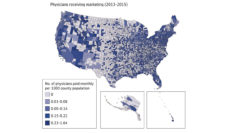The link between parental substance use and children in foster care is long-standing. Interest in this relationship has increased with the opioid epidemic, especially in regards to prenatal substance exposure.
In the United States, states and counties have their own child protective services (CPS) systems to investigate and intervene in concerns of child maltreatment. A 2003 federal law requires all health personnel to inform CPS of infants who are prenatally exposed to substances. CPS agencies rely on information about possible child endangerment from these mandated reporters. Interventions begin from these reports.
Recent research at the Children’s Data Network used population-based linked birth, hospital discharge, and CPS administrative data to identify infants diagnosed with prenatal substance exposure in California. They examined which of these infants were reported to CPS. They found that just over half (53.4%) of infants diagnosed with prenatal substance exposure were reported to CPS.
My colleagues and I conducted a similar study in Washington state. We used a comparable linked administrative dataset of birth, hospital discharge, and CPS records for all children born in the state of Washington and our results were similar to those from California. We found that slightly less than half (42.4%) of infants diagnosed with prenatal substance exposure were reported to CPS.
Both studies analyzed family characteristics, but neither included information about the hospitals where children with prenatal substance exposure were born. Our team wondered if hospital characteristics might be related to the likelihood that an infant diagnosed with prenatal exposure would be reported to CPS. Thus, we conducted a second study that started with the same dataset augmented with information about the Washington state hospitals where the births occurred.
These goals and services need to be communicated to medical providers and implemented by state agencies so that more parents and children affected by the opioid epidemic have access to support services.
We identified 12,308 of the 760,863 children born in Washington state between 2006 and 2013 who were diagnosed with prenatal substance exposure. We used multilevel regression models which allowed us to examine family-level and hospital-level characteristics simultaneously.
Two hospital characteristics increased the likelihood of an infant diagnosed with prenatal substance exposure being reported to CPS. The first characteristic was high demand, as measured by higher average occupancy percentages. The second was a high percentage of poor patients, represented by the proportion of Medicaid revenue. In other words, the busiest hospitals and those who serve many poor patients reported infants born with prenatal substance exposure to CPS most frequently.
Policies and professional medical organizations have called for uniform screening and reporting procedures when responding to substance use during pregnancy. However, our results indicate that responses to prenatal substance exposure are far from consistent. To improve uniform reporting, we recommend targeted training for mandated reporters working in high demand hospitals serving many vulnerable patients. Such trainings must include clear guidance about when referral to CPS is appropriate.
While there is no clear consensus regarding the ‘correct’ amount of reporting of infants diagnosed with prenatal substance exposure, hospital characteristics should not be associated with CPS reporting rates. The goal of the federal legislation requiring notification of infants diagnosed with prenatal substance exposure to CPS is to support families not to punish them. However, this intended family support may not be occurring, given the low number of reports to CPS. It is possible that medical providers are unaware of this goal or available supportive services for these families. These goals and services need to be communicated to medical providers and implemented by state agencies so that more parents and children affected by the opioid epidemic have access to support services.
Acknowledgement
I would like to acknowledge the work of my co-authors on these two papers regarding prenatal substance exposure: Joseph A. Mienko (University of Washington School of Social Work), Emily Brown (Seattle Children’s Hospital), and Ali Rowhani-Rahbar (University of Washington School of Public Health). We also thank our partners at the State of Washington Department of Children, Youth, Families for enabling this work.
Photo by Xavier Mouton Photographie on Unsplash














